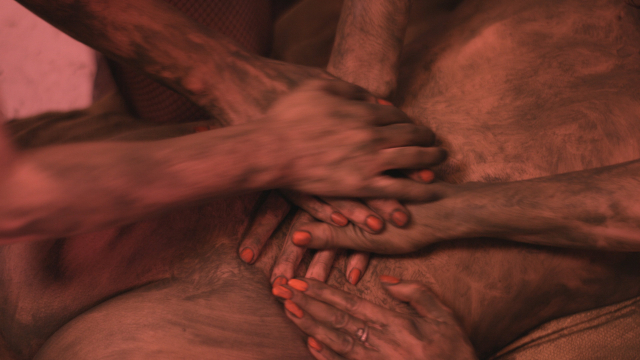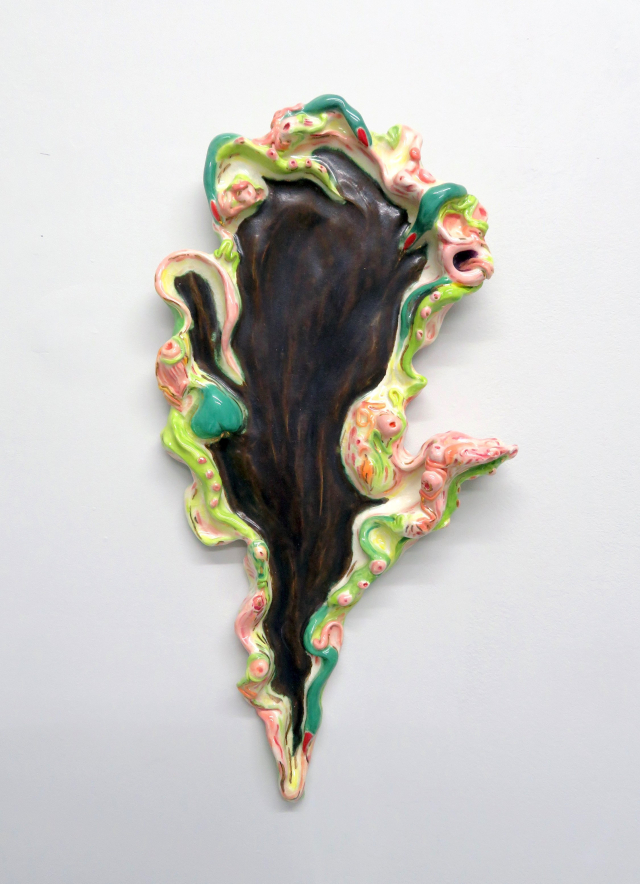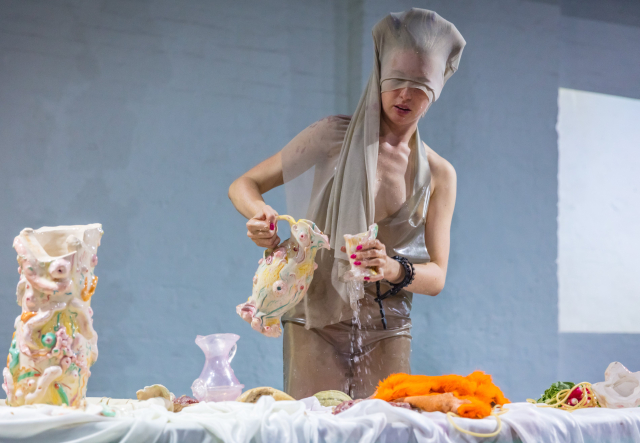Zoe Williams, from the Riva Tunnel to the Sunday fantasy
With a new film Zoe Williams explores secret fantasies and forgotten desires. But the core of the matter is the artist’s ability to shape imagination (with her hands).

Zoe Williams, Sunday Fantasy, 2019; A film by Zoe Williams and Amy Gwatkin, Starring Nadja Voorham and Deniz Unal. Soundtrack by David Aird. Duration: 31’24 minutes. Commissioned by Mimosa House Gallery. Supported using public funding by the National Lottery through Arts Council England. Courtesy the Artist and Antoine Levi, Paris.
—
Even after ‘Sunday fantasy’, the film Zoe Williams presented a few weeks ago at the Mimosa House in London, it seems that the best place where to look to really grasp the poetics of this talented British artist (Salisbury, 1983) is the solo show titled ‘The unruly glove, the green bum and the sickly trickle gloves‘ that Galerie Antoine Levi dedicated to Williams last year. In the series of drawings exhibited in the above mentioned exhibition there are almost all the elements both the new ‘Sunday fantasy’ and ‘Ruffles’, the touching mise-en-scene set up by the artist at Riva Tunnel in Monte Carlo on the opening night of Artmonte-carlo 2019, are based on. Those drawings, executed in pencil and watercolours crayon, that is a medium very similar to the one a master from the last century such as Pierre Klossowski also chose to convey how elusive ideas and their energies can be, are an extraordinarily precise and reliable formal compendium: 1) the acidic colours of the sumptuously laid table where the banquet took place at Riva Tunnel, which are after all the same ones that colour her extremely refined hand glazed ceramics; 2) the curving and twisting line, also a trait that characterises her ceramic and is suggested in ‘Sunday fantasy’ by the eels (glazed by nature) swimming in the blue tank; 3) the ritual of the cake mashed by one of the actors, performed for the first time in the ‘Ceremony of the void’ presented in 2017 at the David Roberts Foundation in London, and proposed again in Monaco – the drawing it refers to in this instance is actually titled Sunday fantasy; 4) the fantasy of a four-hand massage, already present in a drawing titled Flying gloves fantasy (in assorted colours) and in Studies for scenes (Mishaps with Fist etc). We could go on, but this is enough to show how Zoe Williams visual thinking works, and how the artist has developed a well-defined formal language. In this regard it may be useful to mention that in 2015 Zoe Williams won the Troy Town Art Pottery Residency, in the East End of London, a programme that many talented artists took part to: Anthea Hamilton, Steven Claydon, Nicole Wermers, Nicolas Deshayes, Allison Katz, or Ian Law, just to name a few. In spite of the moving images and performances, the work of Zoe Williams is nonetheless deeply rooted in the object of art that she personally makes (link to our article about the rise of traditional techniques in contemporary art).

Zoe Williams, Studies for scenes (Mishaps with Fist etc), 2018. Pencil and watercolours crayon on paper, in artist’s tinted walnut burr frame. Cm. 33 x 45 Private Collection, Monte-Carlo.

Zoe Williams, Sunday Fantasy, 2018. Pencil and watercolours, crayon on paper, in artist’s tinted walnut burr frame. Cm. 33 x 45. Courtesy the Artist and Antoine Levi, Paris.

Zoe Williams, Ruffles, 2019. Performative soirée at Riva Tunnel (Monte-Carlo) on the occasion of artmonte-carlo, April 2019. Courtesy the Artist and Antoine Levi, Paris. Photographs: Manon Boyer.
Zoe Williams, a quasi-political statement.
Having said so, we should now address the topic we brought Monsieur K. into. Zoe William’s performances, as well as her first film – which, incidentally, has been constructed together with her friends and collaborators, that is Amy Gwatkin, Deniz Unal and Nadja Voorham – undoubtedly explore the sphere of eroticism, and that’s how they should be read. The ‘Sunday fantasies’ are those of the main character Veronica Malaise, who is played in turn by the 3 actresses, and by the artist herself. Veronica finds an ancient glass scent bottle in the shape of a shell, which is possessed by the spirit of its previous owner, a lesbian priestess from the Roman Empire – can you recall the Dame Romane by Klossowki and the power of matriarchy? The priestess used the scent bottle and the fluid it contained to make real her erotic fantasies. Here is how the dream becomes an essentially homosexual cinematographic reality, queer (link to our interview with Walter Pfeiffer, a pioneer of the queer photography), vaguely dramatic, subtly ironic, yet ultimately respectful. Just like her performances, carried out on the comparison between food and sexuality, so Sunday fantasy is in no way slighting; it doesn’t try to shock you. Instead of going beyond the limits Williams prefers to explore what she is interested in within socially convenient boundaries. That is, after all, deeply coherent with her choice to learn ceramic art, or to express herself through drawing – it is about developing a discourse, rather than destroying what is already there just for the sake of starting from scratch, or imposing her own vision. However, for a society where, as opposed to the one Klossowki lived in, pornography is a specious debate before being a moral issue, here the choice of remaining within the sphere of eroticism implies a strong political statement. While pornography reduces us to animals (and as such exposes us to the worst forms of manipulation), eroticism speaks to the highest capacity of the human being, that is his own imagination. Williams is somehow to be positioned on a path that is opposite to the one that many ‘they’, recently coming on the scene, are actually walking on.

Zoe Williams, Rotten peach heel, 2019. Fissured hand glazed ceramic with black lustre, creme éclair Cm. 9 x 8 x 25. Courtesy the Artist and Antoine Levi, Paris.

Zoe Williams, Green fingers, 2019. Hand glazed ceramic with metallic lustre Cm. 46 x 23 x 5. Courtesy the Artist and Antoine Levi, Paris.
Empathy and artefacts.
At this point what is left to investigate is the relationship between artefact and imagination, that is between object (movable) and image, on the move. More than Matthew Barney, an artist who as a matter of fact only settled the crucial duality between scene and stage props in the installation (lets look, for instance, at his room at the Schaulager in Basel), here one of the possible models to look at for a better understanding of Williams’ art practice would be the early Francesco Vezzoli, who saw himself as a film director and embroider (Francesco Vezzoli, Trilogia della morte, Fondazione Prada, 2004). Image, movement and artefact are for Zoe Williams all parts of the same research process. However their encounter is occasional rather than functional. Her ceramics are on the table and appear in the films, yet they are just extra. Or, paraphrasing what the voice-over of ‘Sunday fantasy’ tells at some point, objects and images are like internal eyes, that is ‘two different routes to the same pleasure source’. On the one hand, moving images take advantage of the emphatic mechanism thus provoking brain’s responses through recurring elements like animal furs, creams, fluids, insects – thus putting our mirror neurons to work (G. Rizzolati, 1992). On the other hand, her works of art feed on this parallel narrative photographically freezing fragments of it. On one side time uncurls, on the other it crystallises.

Zoe Williams, Ceremony of the Void, 2017. Installation and performance in DRAF Studio, 7 Sept 2017. Thanks to Rochester Square for supporting in kind the production of ceramic works. Costumes by H Y D R A. Courtesy the Artist and Antoine Levi, Paris. Photographs: Dan Weill.
November 7, 2019
